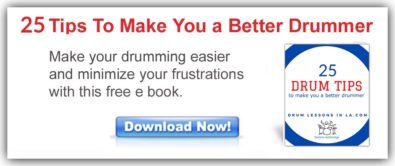
Think of your solo like a song. It has a form and one part flows into another. It helps to write out the different parts so you can see how your solo progresses. And just like songwriters write more than one song, you don’t have to have only one solo. You can have one that is melodic and another that is bombastic, etc. This will help with the urge to play everything you know in one solo.
Here are some specific tools you can work into your solos. This is not a definitive list but feel free to use these ideas if they sound good to you. I highly recommend you record yourself soloing. That way you can let your creativity flow without editing yourself as you play and critique your performance when you listen back. Sometimes what you actually play sounds different than what you thought you played.
A good way to get started is to play an interesting beat for a certain amount of measures and then play different fills for a certain amount of measures. For example, play a beat for three measures and play a fill for the fourth. Keep repeating that pattern while you work up your solo and then change to playing the beat for two measures and fill for two measures. Then play the beat for one measure and fill for three measures.
Besides changing the phrasing to other drums, you can also modulate the time (for example, play a 16th note phrase as 8th note triplets or play your phrase in 3/4 instead of 4/4) or change tempos for a portion of the solo.
Polyrhythms are when you play two different rhythms at the same time. Polyrhythmic figures can add a sense of tension to parts of your solo.
Crossovers are simply when you play a figure where one hand crosses over the other. This can add a big visual appeal.
Pitch bends are when you push down on a drum with one stick while striking it with the other. The more pressure you apply with the stick, the higher in pitch it will be when you strike it. This can give you timpani like sound on the larger toms.
If you are performing your solo in front of an audience, you may want to get them involved in some way. Get them to clap along or respond to a figure you just played. Keeping the audience in mind is always a good idea. Remember that they are there to see you play. Adding something visual like stick flips or playing a part of your solo standing up can add a lot to your performance, if appropriate.

